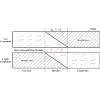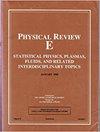使用带有显式焓方程的晶格玻尔兹曼法建立各种材料的三维凝固模型
IF 2.4
3区 物理与天体物理
Q1 Mathematics
引用次数: 0
摘要
基于介观尺度的晶格玻尔兹曼法(LBM)以分布函数的形式表示基于焓的模型,由于其对凝固潜热存在的直接和相对准确的表征,被广泛应用于储能材料的液固相变过程。然而,由于焓分布函数本身包含材料的物理特性,这些特性会在流化过程中与焓分布函数一起转移。这导致基于焓的模型在模拟不同材料混合的相变过程时与实际过程存在偏差。为解决这一问题,本文针对不同类型的材料构建了基于焓的模型。对于多种材料,采用了不同形式的焓分布函数。对于同类物质之间的碰撞和流变过程,该方法仍采用焓分布函数的形式;而对于不同物质之间的热传递,则避免了焓分布函数的直接传递,而是在焓分布函数中加入源项,通过基于温度的混合前后能量变化来表征不同物质之间的热传递。为了验证本文所提方法的准确性,以水滴在空气中凝固为例,建立了两种不同材料的详细凝固模型,并将结果与实验结果进行了比较。模拟结果表明,本文构建的模型与实际过程基本一致。本文章由计算机程序翻译,如有差异,请以英文原文为准。

Three-dimensional solidification modeling of various materials using the lattice Boltzmann method with an explicit enthalpy equation
Based on the mesoscopic scale, the lattice Boltzmann method (LBM) with an enthalpy-based model represented in the form of distribution functions is widely used in the liquid-solid phase transition process of energy storage materials due to its direct and relatively accurate characterization of the presence of latent heat of solidification. However, since the enthalpy distribution function itself contains the physical properties of the material, these properties are transferred along with the enthalpy distribution function during the streaming process. This leads to deviations between the enthalpy-based model when simulating the phase transition process of different materials mixed and the actual process. To address this issue, in this paper, we construct an enthalpy-based model for different types of materials. For multiple materials, various forms of enthalpy distribution functions are employed. This method still uses the form of enthalpy distribution functions for collisions and streaming processes among the same type of substance, while for heat transfer between different materials, it avoids the direct transfer of enthalpy distribution functions and instead applies a source term to the enthalpy distribution functions, characterizing the heat transfer between different materials through the energy change before and after mixing based on the temperature. To verify the accuracy of the method proposed in this paper, a detailed solidification model for two different materials is constructed using the example of water droplets solidifying in air, and the results are compared with experimental outcomes. The results of the simulation show that the model constructed in this paper is largely in line with the actual process.
求助全文
通过发布文献求助,成功后即可免费获取论文全文。
去求助
来源期刊

Physical review. E
物理-物理:流体与等离子体
CiteScore
4.60
自引率
16.70%
发文量
0
审稿时长
3.3 months
期刊介绍:
Physical Review E (PRE), broad and interdisciplinary in scope, focuses on collective phenomena of many-body systems, with statistical physics and nonlinear dynamics as the central themes of the journal. Physical Review E publishes recent developments in biological and soft matter physics including granular materials, colloids, complex fluids, liquid crystals, and polymers. The journal covers fluid dynamics and plasma physics and includes sections on computational and interdisciplinary physics, for example, complex networks.
 求助内容:
求助内容: 应助结果提醒方式:
应助结果提醒方式:


